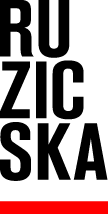Stephane Dafflon
Vincent Szarek
Blair Thurman
27 September – 15 November 2019
STEPHANE DAFFLON (*1972, Neyruz, Switzerland) took his first artistic steps during the early years of computers: graphic design programmes such as 'Illustrator' open up unfathomable opportunities for sketching new concepts. By using this software the artist is able to easily create and change patterns and shapes and subsequently transfer them onto canvas by hand. These works, which STEPHANE DAFFLON titles AST (Acrylique sur toile) with a consecutive number (our exhibition's works are AST 380-383) illustrate the fundamental concepts of Concrete Art. Max Bill, who is considered to be a founder of the Zurich Concrete school, defines it in 1949 in the introduction of an exhibition catalogue as ''acuteness, clarity and perfection''. Geometric shapes, applied onto the canvas with maximum precision, appear as if observed through a kaleidoscope: compared to the reduction of colour and shape in the past years, the work's density and intensity mark the beginning of a new chapter in STEPHANE DAFFLON's oeuvre.
VINCENT SZAREK's (*1973 Rhode Island, USA) new works seem organic, fuid and their reflecting surfaces catch the eye. He learned the precise handling of lacquer when working at a body shop during his studies at the prestigious Rhode Island School of Design and also while working with Jef Koons and Peter Halley. The curved surfaces of the five new wall objects titled U F O S are reminiscent of a distorting mirror. The UFOS reduced colour palette (emerald, gold, grey, chocolate) is inspired by Brice Marden's monochrome works from the early 1970s, most notably the Grove series, infuenced by the colours of the Greek islands: olive trees, lemons, the sea during twilight. In the creation process of the UFOS VINCENT SZAREK expands the sober colour palette by including shimmering gold and blazing turquoise.
BLAIR THURMAN's (*1961 New Orleans, USA) works are dedicated to graphic abstraction and seem to be simultaneously questioning their traditional creation process: the steady application of paint makes way for a more painterly one where each brush stroke is visible. The perfect geometric shape is softened by an organic, curved ductus. The new works No Land Like Show Land, Ribbons & Bows and Lucky Charm School mirror a NASCAR race track in Daytona, Florida. The equally outlandish and aesthetic colour combinations remind the observer of shamrocks, which are known to be good luck charms (Lucky Charm School), or of the LGBT+ movement (Ribbons & Bows). In his works BLAIR THURMAN explores the overlap of cultural environments and fantasy and gives interpretation free rein. Their proposition, at the same time serious and cheerful, speak for themselves and appeal to the viewer: abstraction in its most beautiful form.



